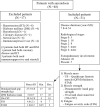Quadriceps femoris muscle ultrasound in sarcoidosis: an observational case-control study
- PMID: 38551519
- PMCID: PMC11255879
- DOI: 10.23736/S1973-9087.24.08232-7
Quadriceps femoris muscle ultrasound in sarcoidosis: an observational case-control study
Abstract
Background: Although loss of muscle mass may be associated with general weakness, intolerance to physical activity and fatigue, it is underestimated and poorly understood in patients with sarcoidosis.
Aim: To compare the quadriceps femoris muscle (QFM) thickness measured by ultrasonography (US) between the female patients with sarcoidosis and controls, secondly to assess the correlation between the muscle strength, fatigue and QFM thickness.
Design: Observational, case-control study.
Setting: Physical Medicine and Rehabilitation Department of a University Hospital.
Population: Thirty-one women with sarcoidosis and 27 healthy volunteers were included in the study.
Methods: The participants were evaluated for the following outcomes: 1) handgrip strength; 2) QFM thickness measured using US; and 3) sonographic thigh adjustment ratio (STAR). The sarcoidosis group was also evaluated with the 30-second chair stand test (30s-CST) and Fatigue Severity Scale (FSS).
Results: The QFM thickness and STAR values of the patients with sarcoidosis were significantly lower than those of the controls (P=0.0001). However, no statistically significant difference was observed between the handgrip strengths of the groups (P=0.581). There was no statistically significant correlation between the STAR values and handgrip strength in the sarcoidosis group; however, there was a significant positive correlation between the STAR values and 30s-CST (r=0.467, P=0.008).
Conclusions: Loss of muscle mass is one of the musculoskeletal conditions in patients with sarcoidosis that may be associated with nonspecific symptoms, such as general debility, intolerance to physical activity, and fatigue. In the present study, no difference was observed in hand grip strength between the groups, while we found that QFM thickness was affected in patients with sarcoidosis when compared to the controls. The ultrasonographic QFM evaluation seems to be an innovative tool which may be used at all stages of sarcoidosis patient follow-up.
Clinical rehabilitation impact: The grip strength is a commonly used test to detect muscle weakness, but onset of a decrease in muscle mass in the lower extremities may occur earlier. Considering the increased burden of musculoskeletal problems in this population, performing 30s-CST and sonographic QFM thickness is practical methods to identify risky patients.
Conflict of interest statement
Figures
References
-
- Nessrine A, Zahra AF, Taoufik H. Musculoskeletal involvement in sarcoidosis. J Bras Pneumol 2014;40:175–82. https://www.ncbi.nlm.nih.gov/entrez/query.fcgi?cmd=Retrieve&db=PubMed&l... 10.1590/S1806-37132014000200012 - DOI - PMC - PubMed
-
- Hutchinson J. Statement on sarcoidosis. Joint Statement of the American Thoracic Society (ATS), the European Respiratory Society (ERS) and the World Association of Sarcoidosis and Other Granulomatous Disorders (WASOG) adopted by the ATS Board of Directors and by the ERS Executive Committee, February 1999. Am J Respir Crit Care Med 1999;160:736–55. https://www.ncbi.nlm.nih.gov/entrez/query.fcgi?cmd=Retrieve&db=PubMed&l... - PubMed
-
- Fayad F, Lioté F, Berenbaum F, Orcel P, Bardin T. Muscle involvement in sarcoidosis: a retrospective and followup studies. J Rheumatol 2006;33:98–103. https://www.ncbi.nlm.nih.gov/entrez/query.fcgi?cmd=Retrieve&db=PubMed&l... - PubMed
-
- Gea J, Casadevall C, Pascual S, Orozco-Levi M, Barreiro E. Respiratory diseases and muscle dysfunction. Expert Rev Respir Med 2012;6:75–90. https://www.ncbi.nlm.nih.gov/entrez/query.fcgi?cmd=Retrieve&db=PubMed&l... 10.1586/ers.11.81 - DOI - PubMed
-
- De Vries J, Rothkrantz-Kos S, van Dieijen-Visser MP, Drent M. The relationship between fatigue and clinical parameters in pulmonary sarcoidosis. Sarcoidosis Vasc Diffuse Lung Dis 2004;21:127–36. https://www.ncbi.nlm.nih.gov/entrez/query.fcgi?cmd=Retrieve&db=PubMed&l... - PubMed
Publication types
MeSH terms
LinkOut - more resources
Full Text Sources
Medical



